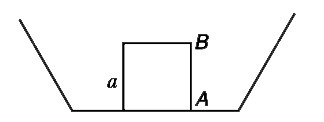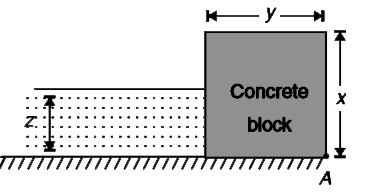When a detonating gas explodes, 34.5kcal ar liberted per gram of hydrogen. Use this observation to ding the minimum emf of a battery at which the electrolysis of water is possible. (A faraday=96,500C.)
The correct Answer is:1.5V
Step by step video, text & image solution for When a detonating gas explodes, 34.5kcal ar liberted per gram of hydrogen. Use this observation to ding the minimum emf of a battery at which the electrolysis of water is possible. (A faraday=96,500C.) by Physics experts to help you in doubts & scoring excellent marks in Class 12 exams.
Topper's Solved these Questions
- BOOK - NN GHOSHCHAPTER - HEATING AND CHEMICAL EFFECT OF CURRENTEXERCISE - EXAMPLE B23videos
HEATING AND CHEMICAL EFFECT OF CURRENT
- BOOK - NN GHOSHCHAPTER - GAUSS THEOREM AND ITS APPLICATIONEXERCISE - EXAMPLES(a)24videos
GAUSS THEOREM AND ITS APPLICATION
- BOOK - NN GHOSHCHAPTER - INTRODUCTION TO MODERN PHYSICSEXERCISE - EXERCISE21videos
INTRODUCTION TO MODERN PHYSICS
Similar Questions
(i) A non uniform cube of side length a is kept inside a container as shown in the figure. The average density of the material of the cube is 2 ρ where ρ is the density of water. Water is gradually fille din the container. It is observed that the cube begins to topple, about its edge into the plane of the figure passing through pointA, when the height of the water in the container becomes a2. Find the distance of the centre of mass of the cube from the face AB of the cube. Assume that water seeps under the cube.

(ii) A rectangular concrete block (specific gravity =2.5) is used as a retatining wall in a reservoir of water. The height and width of the block are x and y respectively the height of water in the reservoir is z=34x. the concrete block cannot slide on the horizontal base but can rotate about an axis perpendicular to the plane of the figure and passing through point A

(a) Calculate the minimum value of the ratio yx for which the block will not begin to overturn about A.
(b) Redo the above problem for the case when there is a seepage and a thin film of water is present under the block. Assume that a seal at A prevents the water from flowing out underneath the block.View SolutionA copper wire having a resistance of 0⋅02Ω per metre is used to wind a 500 turns solenoid of radius 2⋅0cm and length 30cm. What should be the emf of the battery which when connected across the solenoid would produce a magnetic field at 10−2T, near the centre of the solenoid.
View Solution
Knowledge Check
- Question 1 - Select One
Electrolysis is the process in which electrical energy is converted to chemical energy. In electrolytic cell, oxidation takes place at anode and reduction at cathode. Electrode process depends on the electrode taken for electrolysis. Amount of substance liberated at an electrode is directly propertional to the amount of charge passed through it. The mass of substance liberated at electrode is calculated using the following relation :
m=ItE96500
Here, E represents the equivalent mass and 96500 C is called the Faraday constant. Faraday (96500 C) is the charge of 1 mole electron, i.e., 6.023×1023 electrons, it is used to liberate one gram equivalent of the substance.
Calculate the volume of gas liberated at the anode at STP during the electrolysis of a CuSO4 solution by a current of 1 A passed for 16 minutes and 5 seconds :A224 mLB56 mLC112 mLD448 mL - Question 2 - Select One
Electrolysis is the process in which electrical energy is converted to chemical energy. In electrolytic cell, oxidation takes place at anode and reduction at cathode. Electrode process depends on the electrode taken for electrolysis. Amount of substance liberated at an electrode is directly propertional to the amount of charge passed through it. The mass of substance liberated at electrode is calculated using the following relation :
m=ItE96500
Here, E represents the equivalent mass and 96500 C is called the Faraday constant. Faraday (96500 C) is the charge of 1 mole electron, i.e., 6.023×1023 electrons, it is used to liberate one gram equivalent of the substance.
The platinum electrodes were immersed in a solution of cupric sulphate (CuSO4) and electric current is passed through the solution. after sometime, it was observed that the colour of copper sulphate disappeared with evolution of a gas at the electrode. The colourless solution contains :Aplatinum sulphateBcopper nitrateCcopper sulphateDsulphuric acid - Question 3 - Select One
Electrolysis is the process in which electrical energy is converted to chemical energy. In electrolytic cell, oxidation takes place at anode and reduction at cathode. Electrode process depends on the electrode taken for electrolysis. Amount of substance liberated at an electrode is directly propertional to the amount of charge passed through it. The mass of substance liberated at electrode is calculated using the following relation :
m=ItE96500
Here, E represents the equivalent mass and 96500 C is called the Faraday constant. Faraday (96500 C) is the charge of 1 mole electron, i.e., 6.023×1023 electrons, it is used to liberate one gram equivalent of the substance.
The quantity of electricity required to liberate 112 cc hydrogen at S.T.P. from acidified water is :A965 CB9650 CC96500 CD4825 C
a. Which isotpe of hydrogen is used as a tracer in organic reactions.?
b.Concentrated H2SO4 cannot be used for drying H2. Why?
c. The electrolysis of water of manufactures H2 gas is always carried out in presence of acid (H2SO4) or alkali (KOH), yet no SO2−4 or K⊕ are discharged. Why?View SolutionRavi was performing some experiements related to the laws of chemical combination in the science laboratory under the guidance of his chemistry teacher Mr. John. Ravi found that when he burned 1 gram of hydrogen gas in 8 grams of oxygen gas in a closed vessel, he obtained 9 grams of water. He repeated this experiment many times but obtained the same results every time
(a) Write a balanced chemical equation for the reaction between hydrogen and oxygen to form water. Also write the names of all the substances involved below their formulae in the equation
(b) What are the reactants and products in the above reaction ?
(c) Which law of chemical combination is illustrated by the fact that when Ravi burned 1g of hydrogen in 8g of oxygen, he obtained 9g of water ?
(d) What mass of water will be obtained if 1g of hydrogen is burned in 10g of oxygen ? Which law of chemical combination will govern your answer ?
(e) What values are displayed by Ravi in this episode ?View SolutionHydocarbons, obtained from coal and coal tar and from oil and gas wells, are organic compounds composed entirely of C and H. A 0.1647g sample of a pure hydrocarbon was burned in a C−H combustion train to produce 0.4931g of CO2 and 0.2691g of H2O. Determine the masses of C and H in the sample and the percentages of these elem ents in the hydrocarbon.
Strategy:
Step 1. Use the observed mass of CO2 to determine the mass of C in the original sample using the information that there is 1mol of C atoms in each mole of CO2.
Step 2. Use the observed mass of H2O to calculate the mass of H in the original sample using the fact that there are 2mol of H atoms in each mole of H2O. (We can also calculate the mass of H by subtracting the mass of C from the mass of sample. However, it is good experimental practice, when possible, to base both on experimental measurements as this would help to check for errors in the anlysis of calculation.)
step 3. Calculate the percentages by mass of each element in turn, using the relationship
% Element =Gram of elementGram of sample×100%View SolutionChemical reactions involve interation of atoms and molecules. A large number of atoms / molecules ( approximately 6.023×1023) are present in a few grams of any chemical compound varying with their atomic / molecular masses. To handle such large numbers conveniently, the mole concept was introduced. This concept has implications in diverse areas such as analytical chemistry, biochemistry, electrochemistry, and radiochemistry. The following example illustrates a typical case, involving chemical / electrochemical reaction, which requires a clear understanding of the mole concept.
A 4.0M aqueous solution of NaCl is prepared and 500mL of this solution is electrolyzed. This leads to the evolution of chlorine gas at one of the electrodes ( atomic mass of Na is 23 and Hg is 200)(1F=96500C).
The total charge ( coulomb ) required for complete electrolysis isView SolutionWhen 1 gm hydrogen (e.c.e.=1.044×10−8kg/C) forms water, 34 kcal heat is liberated. The minimum voltage required to decompose water is
View Solution

